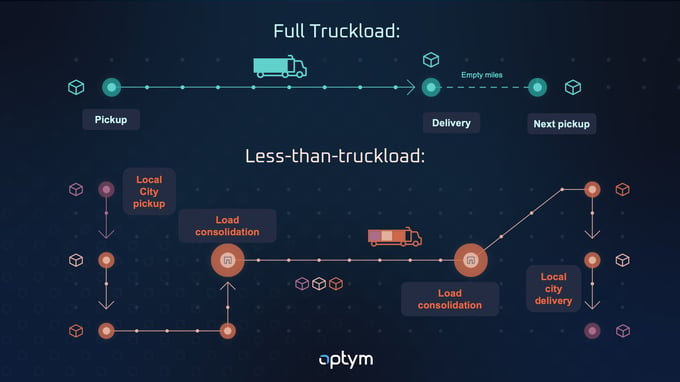As we transition from the first quarter of the year, many of us wonder what the current state of the LTL trucking industry is and what we can expect in the months to come. Understanding the emerging trends, competitor performance, and general industry dynamics is essential to adjust our operational strategies in this sector. This blog provides a brief overview of the market, the main players' financial performance, and everything you need to know about the industry in 2024.
What is less-than-truckload?
Less-than-truckload (LTL) refers to a mode of freight transportation where multiple shipments from different customers are consolidated into a single truck for delivery and usually includes multiple steps like local pickup, sorting at terminals, line haul transportation, destination sorting, and local delivery.
According to the latest research, the United States LTL market is expected to reach $109.2 billion in 2024 and continue to grow at a steady rate of 4.19% in the next years. Even though the LTL sector is only comprised of approximately 700 U.S. business entities, it enhances the logistical capabilities of the U.S. economy, supports businesses in maintaining competitiveness, promotes job creation, and plays a key role in adapting to and supporting the evolving demands of commerce and trade.
Top 10 largest LTL players in 2024
The landscape of the U.S. Less-than-truckload (LTL) market in 2024 is expected to remain highly competitive and concentrated, with the top ten LTL carriers showcasing a significant hold on the market. The top 25 LTL players control more than 80% of the LTL capacity and thus have significant influence over pricing. This table presents a snapshot of these leading LTL carriers, featuring their fleet sizes and financial performance, illustrating the scale and economic impact of their operations within the industry.
Company
|
Fleet size (FMCSA)
|
Annual revenue 2023
|
| FedEx Freight |
17,927 |
$21.7 B |
| Old Dominion Freight Line |
10,719 |
$5.8 B |
| R+L Carriers |
9,795 |
$2.0 B |
| XPO |
8,896 |
$7.7 B |
| Estes Express Line |
8,586 |
$6.0 B |
| TFI International |
N/A |
$7.5 B |
| Saia Inc |
6,177 |
$2.8 B |
| ABF Freight |
4,427 |
$4.4 B |
| Central Transport |
4,060 |
$1.2 B* |
| Dayton Freight Lines |
2,118 |
$1.9 B |
LTL industry trends
Growth through consolidation and acquisitions
The LTL industry is witnessing notable growth through strategic purchases and expansions. Estes Express Lines and XPO, for example, have acquired terminals from Yellow Corp after its bankruptcy, significantly increasing their service capacity and geographical reach. Similarly, TFI International has enhanced its market presence by acquiring Hercules Forwarding, indicating a clear trend toward consolidation.
Along with acquiring terminals major players are creating larger LTL networks, including Omni logistics and Forward Air, Mullen Group, and even Knight-Swift Transportation.
Rates are expected to increase
In 2024, LTL rates are projected to increase, continuing the trend from the previous year. According to Avery Vise, Vice President of Trucking at FTR, rates are expected to rise by an average of 4.1%, following a 2.4% increase compared to 2023.
More technology adoption
The push towards digitalization and fleet optimization solutions will keep gaining traction in 2024. Last year, some of the largest LTL carriers continued partnering with Optym to incorporate more fleet optimization solutions. Optimization technology adoption is expected to continue, and it is estimated that 90% of all commercial truck fleets will use some form of optimization technology by 2025. Regarding digitalization adoption, this quarter, C.H. Robinson announced the implementation of an electronic bill of lading (eBOL) with ten of the top LTL carriers showing the industry commitment to use technology to improve their operations.
Dynamic pricing keeps heading LTL’s way
Last year, we observed how some of the largest LTL carriers started ripping the benefits of dynamic pricing in response to low freight volume. Coyote Logistics asserts that we can expect this trend to continue in 2024 as more LTL carriers develop dynamic pricing models for their transactional freight.
LTL software
In an industry where every mile, minute, and dollar counts, the importance of LTL software cannot be overstated. LTL software offers carriers the ability to orchestrate their logistics with precision and efficiency. Optym’s unified LTL suite helps carriers optimize their pickup & delivery, network planning, driver scheduling, freight pricing, and more.
 Estes and Optym expand strategic partnerships to revolutionize LTL Operations.
Estes and Optym expand strategic partnerships to revolutionize LTL Operations.
This strategic collaboration focuses on improving first and last-mile efficiencies by incorporating cutting-edge tools like RouteMax and DockAi. Discover how this partnership is setting new standards for operational efficiency in the LTL sector making operations safer, efficient, and profitable.
LTL news
FAQs
LTL vs FTL
Less-than-truckload (LTL) and Full Truckload (TL) core differences are the amount of space the freight takes in the truck, the costs, the shipping times, and the handling process. Full truckload transportation involves moving shipments requiring the truck’s full capacity from point A to point B. TL is the best choice when quick, dedicated delivery is required. This mode reduces handling risks but comes at a higher cost.

LTL carriers are segmented into six main types: National, Multi-regional, Sub-regional, Asset-light, Load-to-ride, and Reefer. Each type serves specific shipping needs, offering unique benefits based on freight size, regional coverage, and service requirements. This classification helps shippers tailor their choices to optimize efficiency and cost. For a comprehensive breakdown of each LTL carrier category, dive into our detailed article.
Selecting the right Less-Than-Truckload (LTL) carrier is pivotal to optimizing your logistics operations. Understanding key factors such as the National Motor Freight Classification (NMFC) system, which classifies freight to standardize pricing across the industry, is crucial. It's equally important to consider each carrier’s handling of shipments, including their rules on freight dimensions and potential additional charges for oversized shipments.
LTL shipping rates
LTL shipping rates play a crucial role in determining the cost-effectiveness and efficiency of transporting smaller freight quantities, making them a pivotal consideration for businesses and shippers seeking reliable and cost-efficient transportation solutions. Typically, LTL carries have a base rate per hundredweight (CWT), which is then adjusted based on the specific characteristics of the shipment. These are some of the most common factors affecting LTL rates:
- Weight: Rates are based on shipment weight, or the number of pallets used. Typically, heavier shipments cost less per hundred pounds.
- Density: Density and cube weight also influence rates. Larger shipments or those occupying significant trailer space incur higher charges.
- Distance: Longer distances generally mean higher costs per pallet or hundredweight, although proximity to service centers can impact rates.
- Additional services: Extra services like tailgate assistance or private residence pickup or delivery come with additional charges.
- Fuel surcharge: To account for fluctuating fuel prices, carriers add a fuel surcharge based on a percentage of the base rate, published weekly by organizations like the Freight Carriers Association (FCA).